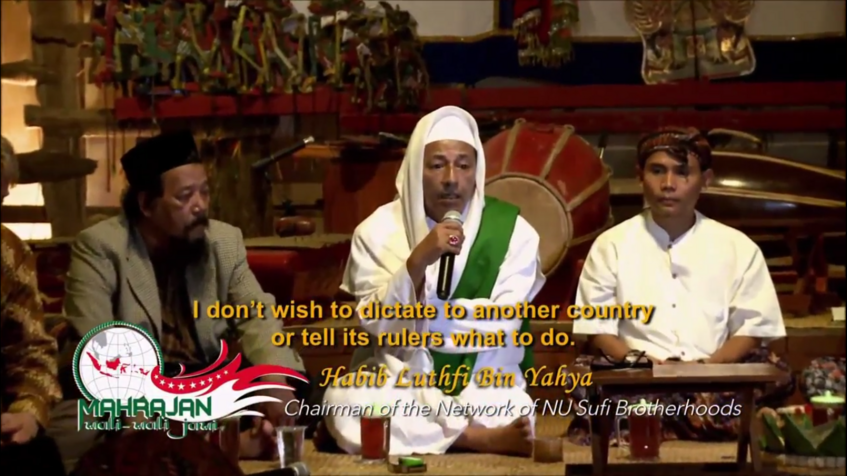This is where we analyze, contextualize and translate materials by groups like ISIS as well as Arabic responses to these groups.
"Islamic State" Briefing Series - Part 4 of 4
Strategic targeting of selected audiences using foreign fighters
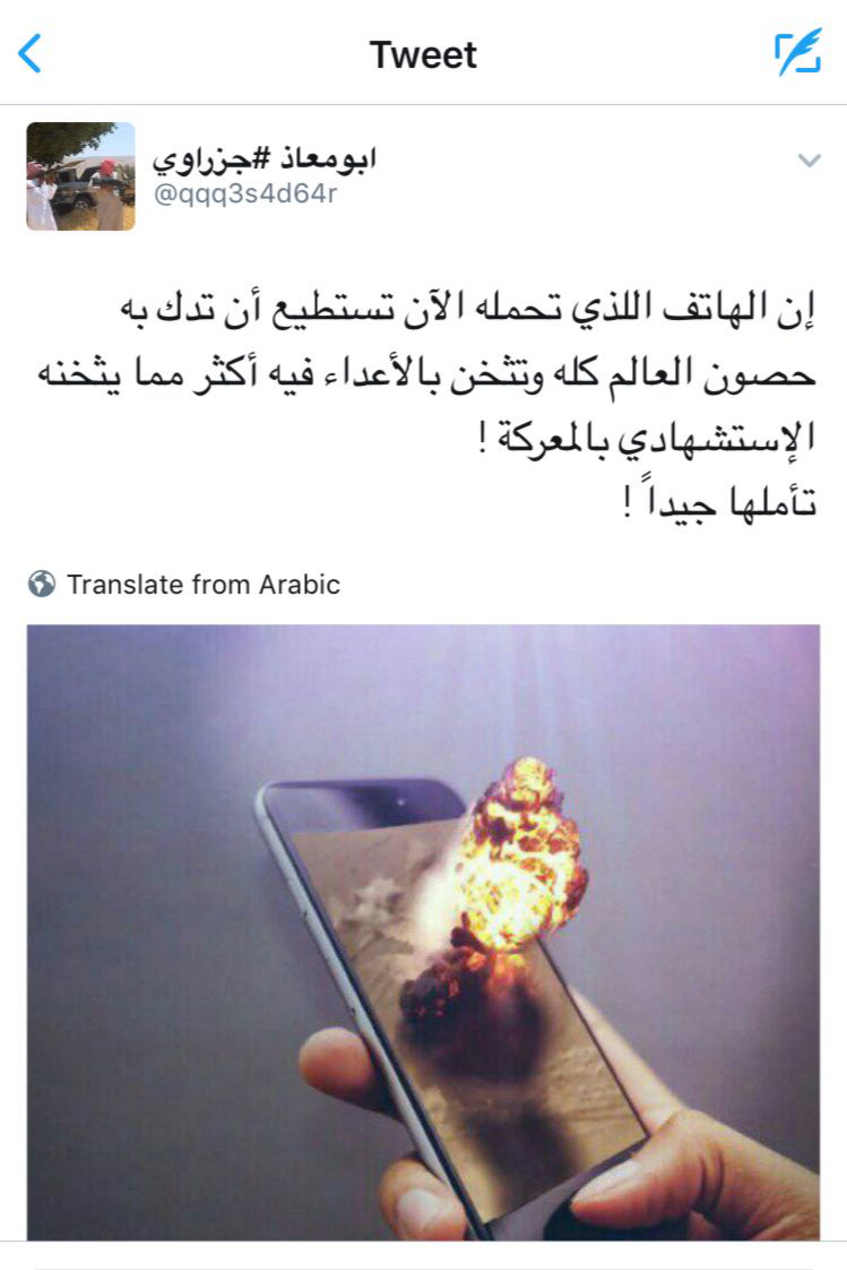
Professional as much as common phone cameras are the most effective passageway between real-life and the virtual world. AQ initiated - and theologically sanctioned - using the Internet as a basis to call to Islam. This is inseparably tied to militant actions and terrorist operations. IS has learned valuable lessons in using and praising the media work and understands how to use foreign fighters best: in front of cameras instead as cannon fodder at the front lines. Non-Arab foreign fighters do not, however, appear so often in videos on social media. When they do, they usually convey their individual and personal motivation as to why they have joined IS, explaining in their own words and language to potential recruits in their home countries what "real-Islam" is, while often addressing legitimate and real grievances and injustices endured by Sunni civilians in, for example, Syria.
IS has taken the lead in producing mainly Arabic language videos to incite a global Arab audience by popularizing their fighters, ideologues and preachers as ultimate role models, modern day Islamic warriors, or simply as defenders of Sunni communities in time of suffering. It presents itself as an Arab movement fighting for independence, yet welcoming non-Arab Muslim foreign fighters into their ranks who are used strategically and on a tactical level for jihadist media, the battlefield or the hinterland such as Raqqa where they can be of value to the state-building efforts. Foreign fighters tend to address their target audience in their respective languages, and oftentimes they are featured in special videos with Arabic and non-Arabic titles. This applies to Brits,[1] Germans, Austrians,[2] French,[3] Russians,[4] and so on, while the overwhelming majority of IS (and AQ) videos is in Arabic featuring native Arabs.
It must be noted that non-Arab foreign fighters fulfil another role anticipated by the IS media strategists: talking about personal commitment and motivation to have undertaken the emigration (hijra) to the "Islamic State" gives the speaker the ability to explain what other motives have led him to this decision. Non-Arab foreign fighters tend to be keen to explain in their language aspects of jihadist theology, potentially initiating or drawing their audience into reading magazines such as Dabiq to further their education on religious concepts such as "tawhid" (monotheism) or "shirk" (polytheism). Take the case of Philipp Bergner, from Dinslaken, Germany. He was featured in a 50 video series (no. 32) entitled "Windows into the Epic Battlefield", showing the very early progress of IS in Syria and Iraq in 2013/4. Bergner is a convert who addresses his personal motivations to join IS, boosting the "Sunni Muslim identity" as a reality while outlining his "path to God."
A almost similar video was released in early September 2016, featuring another German convert who addresses his audience, just like Philipp Bergner, in German. The video, min al-zulumat ila l-nur, "from darkness into the light", is about justice for people in times of war and fighting for the application of shari'a law as means of justice, showing the German convert soothing a Muslim thief whose hand is amputated as punishment.[5] Germans and German-language videos in particular emphasize the many injustices against Muslims in Syria and Iraq and seek to appeal to individuals who have the desire to help, stressing altruist narratives taken out of the rich history of Islam.
Sitting in front of rubble and debris, likely the result of an airstrike, holding a Kalashnikov assault rifle, Bergner introduces himself and asks the viewers to consider who the creator is, and why the human body in its complexity can only be the product God. Much like the complex and fine-tuned mechanics of a clockwork:
"this cannot be a coincidence and that is why I became a Muslim. Every prophet was sent by one God[6] - and Islam means submission to the oneness (tawhid) of God. That is the translation of Muslim in German. And I am a Muslim. A German Muslim. You too can think about the meaning of life and submit yourself to God as I did."
These words may seem as simpleminded but reflect a fundamental pedagogy to explain what is means being a Muslim and thus refuting the Christian tradition of the trinity, which is considered a violation of the principle of tawhid. - and hence is termed as 'polytheist' or shirk. Such an explanation is clear to the overwhelming majority of "native" Sunni Muslims, especially to Arabic native speakers. Abu Usama is outlining the - in his mind - logical explanation to submit to the oneness of God who is the creator of all life. This is the core concept of Islam hijacked by the Sunni extremists: what it means to be a Muslim and the framework of tawhid. He then continues:
"I migrated to Syria to make the word of my creator the highest. For man-made laws are unjust as we see in this world. Most of the world's resources are in Africa; why are Africans the poorest people in this world? You need to ask yourselves that those politicians in suits are devils who rule by their man made laws and have no interest to satisfy God. They don't even believe in God. They are doing their thing for profit on this earth and we want justice. That is why we are combatting the leaders of the disbelievers and whoever follow them. So that justice and God's law will rule the earth, for God has created this earth and He is the king of kings (...).
All praise be God, I have joined the caravan of jihad as I've said to make the word of God the highest and we are not going to stop until we have achieved this. If we are killed those who come after us will continue to complement the path, for God has promised us this."
The message is clearly stated - fighting for IS means being a Muslim. A Muslim can only live within a Islamic community (umma). This umma is Islamic only if it is governed by sharia law, or applied theology by the extremists' standards.
[1] English is aside from German, French and Russian an important language. Hence the IS magazine "Dabiq" is published in English to ensure a maximum readership worldwide, including the mainstream media outlets. British and American foreign fighters appear from time to time. For example, a video released by Markaz al-Hayyat li-l 'ilam, featuring a British, French and German foreign fighter entitled "Wait. We are also waiting." October 16, 2014.
[2] For example in a video uploaded from the IS province Wilayat Hims featuring Austrian-Egyptian Muhammad Mahmud and a German by the nom de guerre Abu 'Umar al-Almani. "Siyahat al-Umma - Der Tourismus dieser Umma". Wilayat Hims, August 5, 2015.
[3] For example: the French language nashid "Tend ta main pour l'allégeance", with English subtitles. Markaz al-Hayyat li-l 'ilam. May 24, 2015. French is also an important language to reach out to Francophone Muslims. A French speaking Mujahid addressing France threatening future attacks are imminent is concluded by the speaker executing a captured Syrian army soldier in the province of Hama in a video published on July 24, 2015. "Wa ma zalamnahum wa-lakin kanu anfusahum yuzlamun". Wilayat Hama, July 24, 2015.
[4] With a majority of foreign fighters coming from the Caucasus region, IS has a special and Russian-language only media department "al-Furat" that promotes Russian, mainly Chechen, fighters and ideologues.
[5] Min al-zulumat ila l-nur, wilayat al-Furat, September 2, 2016.
[6] The Arabic subtitles clarify the statement, bi-tawhid allah, "by the oneness of God", prophets are dispatched in order to spread the worship to God, Him alone, without partners.
"Islamic State" Briefing Series - Part 3 of 4
Controlling territory – applying theology as absolute public and private governance
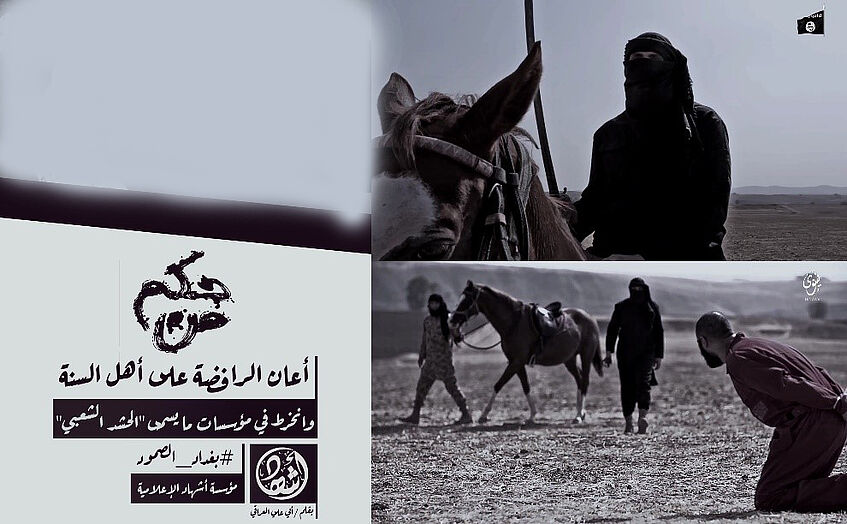
Picture 1 - Showing parts of a cover and screenshots from an execution video.
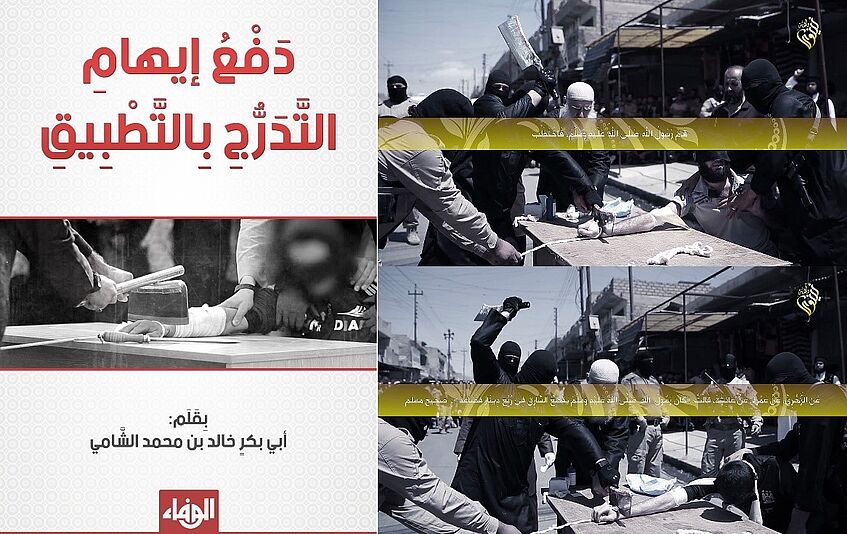
Picture 2 - Showing a booklet and screenshots from a video concerning the punishment for thieves.
Unlike AQ, IS controls swathes of territory in the Sunni Arab heartlands, primary in Iraq and Syria. The theology which was largely theoretical in the case of AQ is now applied in full by IS - making the "state" a real and attractive alternative where the imaginative "real-Islam" promoted by AQ has now become a reality with IS. Sunni extremism - as much as any religious form of extremism or orthodoxy - is driven by an absolute belief in God whereas the application of absolute formalized religious rule is the desired final objective (and the only solution to minimize the threat of living in a state of sin, which would send you to hellfire). For over three decades, jihadists in their own words, both in writing and on film, have been yearning for the creation of an Islamic State and, ultimately, the return of the Caliphate. The power of the self-designated "Islamic State" nurtures on this desire, and the extremist tradition of calling for this restoration of power, as a driving force and an identity marker.
The application of theological concepts written since the 1980s gives IS the power to claim to have restored the "abode of Islam" (dar al-Islam) and clearly demarcate who is a Sunni Muslim and part of the Sunni community - and who is not. Apostates or traitors, who thus are excommunicated (takfir) and executed as alleged spies[1] or "wizards" who conduct black magic[2], homosexuals who are dealt with as "the people of Lot" and pushed from rooftops to death[3] signify a clearly implemented theology IS openly advocates online - and enforces offline. "Islam" has been restored and is now embodied by the "state". In their own words, responding in September 2015 to the refugee crises, IS presents itself as the only legitimate zone where Sunni Muslims can exercise their duties to God accordingly as,
"the whole world, from east to west, became dar al-kufr, the "abode of the disbelievers". Therefore God set in motion the establishment of the Islamic State. This state consists of numerous elements that make it dar al-Islam. Therefore, the rule of shari'a law returned as well as the implementation of physical punishment (al-hudud),[4] cutting off the hands of thieves, punishing adultery by stoning to death and beheading wizards. The establishment of the Islamic State as a reaction to those who commit injustice, governed by "commanding right and forbidding wrong"[5] while driving a jihad against the disbelievers - thus the might of the Islamic community has been restored. Muslims living in the state openly manifest the rituals of their religion[6], not fearing anything apart from God - therefore the state of Islam is the abode of Islam in this era. It is obligatory for every Muslim to support and protect it, to openly display dissociation and enmity to the enemies of the Islamic State."[7]
For IS this means there is only one Islamic state in the world and it is every Muslims' obligation to support this project. The element of applied theology, however, is often expressed in IS videos where the filmed executions or applied punishments are backed by writings (see Picture 1 on the left, with a part of the cover censored). An execution video released on October 18, 2015 from the IS-province (wilaya)[8] Nineveh shows a mujahid armed with a sword mounted on a horse chasing towards a prisoner kneeling on the desert ground. The executioner arrives in a setting deliberately re-enacting the early Muslims on a raid, being a murabit, a horseman ready for war while spiritually tuned to defend his territory and being willing to enter paradise.[9]
A 13-page-document released about a year later by the Ashhad Media foundation took a screenshot of the October 2015 video to project visual coherence[10] to those who have seen the movie: this is a theological booklet justifying and explaining "the ruling on those who support the Shiites against the Ahl al-Sunna", written by Abu 'Ali al-'Iraqi.
Al-'Iraqi alludes to what is generally applied in such IS execution videos - the Sunni jihadist argumentation concerning who has pledged loyalty to God and who has violated this pledge. It engulfs the concept of "dissociation" (al-bara') from disbelievers and the absolute loyalty (wala') to God that was made popular by AQ ideologues, including writings by Osama bin Laden.[11] In the video, several men are beheaded for their betrayal of the ahl al-Sunna (as embodied by IS) as they are accused of having conducted espionage against Shiite militias and the Iraqi government, considered a Iranian-Shiite proxy by IS. As the "caliphate" has been re-established, the obligatory pledge of allegiance (bay'a) to Abu Bakr al-Baghdadi means per definition that all loyalty is to God, via al-Baghdadi, as the human representative (khilaf) in the "state" (dawla).
As second sample of applied theology spread via Telegram are the hundreds of IS videos showing the amputations of hands.
On the left (Picture 2), a cover of a 20-page- book gives the readers a detailed analysis on the permission to exercise physical punishments against transgressors.[12] The arguments are exclusively referring to historical scholars, selected passages from Quran and Sunna as well as precedents from historical role models.
On the right side are two screenshots from the video "the ruling of the creator (God) upon the thief", released by the IS province Nineveh in mid-2015.[13] They show, prior to the act of amputating the two thieves hands in public, religious references appearing as texts to sanction and fully validate this act of punishment according to sharia law. This is a highly appealing message that IS wants to exploit in its videos: the "Islamic State" is based on religious scripture and thus is the only true community of Sunni Muslims, and: IS is acting on behalf of God.
[1] For example: Tahalafuhum wa-irhabana, wilayat Nineveh, July 20, 2016 shows the execution of alleged Kurdish spies by French foreign fighters who avenge killed civilians resulting from airstrikes and praise the lone wolf attack in Nice. The attack on Bastille Day by a lone wolf driving a truck into crowds on the Promenade des Anglais resulted in the death of 86 people.
[2] La yuflih al-sahir haythu ati, wilayat Barqa, December 5, 2016
[3] 'Am 'ala l-fath, wilayat Nineveh, June 11, 2015.
[4] i.e. the amputation of hand and/or feet as punishment for crimes. This form of jurisdiction is also documented by IS videos to showcase being a functioning state: iqama hadd 'ala sariqayn, wilayat gharb Ifriqiyya, November 2, 2015.
[5] IS has released several documents and videos, sanctioning and showing the destruction of, for example, Shiite mosques, churches, Yazidi shrines, graveyards, or the total obliteration of pre-Islamic statues as well as museums housing these artifacts. "Commanding good and forbidding evil" is the theological legitimacy for the Islamic police, who apart from safeguarding the Sunni integrity by systematically removing sites of veneration that violate the Sunni extremist theology also police communities and, for example, ensure the illicit trade and consumption of tobacco is persecuted. For details: Nico Prucha, Reformatting Space: The Self-Proclaimed "Islamic State's" Strategy of Destroying Cultural Heritage and Committing Genocide, European Union National Institutes for Culture, November 2015.
[6] Which had been previously banned or could only be taken care of in secrecy under secular Arab regimes to avoid being arrested for possible Islamist oppositional work.
[7] Suhayl al-Najdi, Luju' al-Muslimin ila ard al-salibiyyin wa-l iqama fiha, Mu'assassat al-Wafa', September 2015.
[8] Wa-in 'uddatum 'uddna, 2, wilaya Nineveh, October 18, 2015.
[9] The comprising theological concept of ribat is discussed in: Nico Prucha, Jihadists' Use of Quran's ribat concept," Jane's Islamic Affairs Analyst, August 2009.
[10] Abu 'Ali al-Iraqi, hukm a'an al-rafida 'ala ahl al-Sunna, Mu'assassat Ashhad li-l 'ilami, October 9, 2016.
[11] Osama bin Laden, tawjihat al-minhajiyya, Minbar al-Tawhed wa-l Jihad, 2006.
[12] Abu Bakr Khalid bin Muhammad al-Shami, Daf'u iham al-tadarruj bi l-tadbiq, Mu'assassat al-Wafa', 2016.
[13] Hukm al-khaliq bi haqq al-sariq, wilaya Nineveh, June 4, 2015.
"Islamic State" Briefing Series - Part 2 of 4
The Framework of Jihadist media and the significance of the content it conveys
This article focuses on IS in their own words. It must be stressed that the overwhelming majority of propaganda released by the group is in Arabic, thus targeting an Arab audience primarily, but not exclusively. IS publishes a rich blend of propaganda on a daily basis, ranging from text documents to professionally produced videos. Any release by IS - as much as by AQ - seeks to inform, educate and convince the consumer that the jihadists are the only "true" Muslims, following the correct "prophetic methodology"[1]. In particular video releases by IS seek to deliver in a clear and absolute image of what "Sunni Muslim" identity should be, according to them.
Religious references to the ahl al-Sunna wa-l jama'a are often made[2], meaning the Sunni Muslims who act according to the prophetic tradition (Sunna), emulating prophet Muhammad and his companions. Sunni extremists claim to be in the closest proximity to God by re-enacting the example and guidance, as set by the Sunna of prophet Muhammad and his companions (sahaba). IS has taken this concept, which was also used by AQ, to a new level by popularizing their slogan "upon the prophetic methodology" ('ala minhaj al-nubuwwa). This means that they justify every action, ranging from the destruction of Shiite mosques to the execution of non-Sunni Muslims, with reference to certain, selectively chosen parts of divine scripture and the prophetic tradition. All of these actions are documented by jihadist media operatives, who then produce professional, full high definition 16:9 videos. These videos get released on social media platforms, that, in turn push contents onto the mobile devices and desktop computers of users.
The professional media output by IS is far greater than just the English-language, tabloid- styled "Dabiq,"[3] just like the range of al-Qaida has always been wider than the English-language Inspire magazine .[4] In Western discourse, there is a tendency to focus on such English language products. However, not even the theological codes in English-language propaganda magazines such as Dabiq, or Rumiyah[5] is evident for those who cannot read Arabic language writings and lack understanding of the religious references. For Arabic speakers who have read 'Abdallah 'Azzam's books from the 1980s, Osama bin Laden's declarations in the 1990s, or Abu Mus'ab al-Zarqawi's statements in the 2000s (just to name the most known ideologues), the videos of IS offer a rich blend of theological and practical narratives (such as combat related items) and provide a window into who the audience are, as well as the true power IS holds. The group has,, for the first time ever in the history of modern jihadist movements, the power to apply theology on a massive scale within the Arab world, primarily Syria and Iraq. The theoretical framework penned by historic and contemporary ideologues provides a coherent textual fundament from which IS draws in their visual output.
This power is furthermore enhanced by the ability to project influence beyond the self-proclaimed "caliphate" by using social media as launching pad. Sunni extremists, referred to as jihadists in this article, seek to fulfil two objectives that are considered divine commandments: (i) commit to militancy often termed as jihad bi-l sayf (jihad by the sword) while (ii) dedicate oneself to calling to Islam.[6] Sunni extremists, militant as well as non-militant, refer to this as jihad bi-l lisan (jihad by the tongue).[7]
IS has proven to be a highly flexible group, being resilient both online as much as offline. However, what is often overlooked, is that IS lacks the flexibility to adapt its ideology, when it would be perhaps convenient for the group, or when facing pressure from its adversaries. If Abu Bakr al-Baghdadi would be caught smoking or drinking wine, for instance, the group and its legacy would fall apart in an instant.
[1] AQ often referred to 'aqida (creed) and minhaj (methodology) when outlining what defines a Sunni Muslim. This ranges from proper prayer conduct to destroying graves of holy men (awliya') whenever possible. The claim to re-enact the lives of early Muslims under the command of prophet Muhammad, acting on said "prophetic methodology" and applying divine laws as opposed to man-made laws is not new. Abu Mus'ab al-Suri (2004) romanticized about this as one of the objectives for any mujahid in his 1600 page long book "Global Islamic Resistance Call" (pages 42, 92). Al-Suri referenced a popular hadith, predicting "the return of the caliphate upon the prophetic methodology." Ayman al-Zawahiri in his "fourth open interview" (2007), conducted online and published by al-Sahab, demanded that Sunni jihadist organisations in Iraq ally with "the Islamic State in Iraq" to liberate territory and consequently re-establish the "abode of Islam" by introducing the "prophetic methodology".
[2] For example the major IS video release "The Clanging of the Swords, part 4", published in May 2014. The video shows IS in the early stages of conquest and consolidating territory in the al-Anbar province of Iraq. Ali Fisher, Nico Prucha, Is this the most successful release of a jihadist video ever?, Jihadica, May 2014.
[3] Dabiq is a English language magazine that is irregularly published by IS. The magazines are referencing Arabic religious key words transcribed in Latin to their readers, thus conveying to those who seek to initiate themselves in the religious universe of IS a set of theological concepts and definitions. The theology is applied and enforced by role models, lone wolves who struck targets in their home countries (Dabiq no. 6) "and thereby has his past history of shirk and transgression completely erased"; or explaining "tawhid and our duties to our parents", as stated in Dabiq no. 12. "The burning of the murtad pilot" (Dabiq no. 7) outlines the legality to kill a Sunni Muslim and the theological parameters to declare him an "apostate".
[4] The term "inspire", for example, is a reference to two verses of the Qur'an (4:84 / 8:65), thus a direct citation of God to "incite/inspire the believers." The same word for "inspire", "incite" in a different form refers to a rhetorical methodology to deliver a motivational / incitement speech (tahrid).Tahrid by means of jihadist media is portrayed as a logical divine command to inspire and incite fellow Muslims by all means to combat the defined enemies in the name of God. This has become an ideological category of itself in the vast corpus of the online jihad materials where self-appointed clerics use tahrid as a rhetorical gateway to convey theological means according to extremist interpretation.
[5] Rumiyah (Rome) is the name of a tabloid-styled glossy IS magazine, published in roughly a dozen languages. The name "Rome" stems from a hadith, cited in the respective language on the last page of the Rumaya magazines: "Which of the two cities will be conquered first? Constantinople of Rumiyah? He [prophet Muhammad] peace and blessings upon him replied: "The city of Heradius will be conquered first", meaning Constantinople." Reported by Ahmad and ad-Darimi from 'Abdallah ibn 'Amr."
[6] Da'wa is the equivalent of missionary work as usually referred to in Western discourse.
[7] Both references, jihad by the sword as well as the tongue are based on Ibn Taymiyya's understanding thereof, whereas Ibn Taymiyya declares "jihad by one's hand, heart, and tongue." Ibn Taymiyya, Qa'ida fi l-inghimas al-'adu wa-hal yubah? Riyadh: Adwa' al-salaf, 2002, 19. The first generation of al-Qaeda on the Arab Peninsula (AQAP) referenced the "tongue" as part of the overall endeavour to commit themselves to God and using violence to deny the application of man-made laws: "We call all Muslims to work on behalf of the religion of God, and to jihad on the path of God, by dedicating one's live, financial abilities and one's tongue.""Statement by the mujahidin on the Arab Peninsula regarding the latest declarations by the Ministry of Interior", translated and commented in Nico Prucha, Die Stimme des Dschihad - al-Qa'idas erstes Online Magazin, Verlag Dr. Kovac: Hamburg, 2010, 137-144.
"Islamic State" Briefing Series - Part 1 of 4
The "Islamic State" & Social Media – from Theory to Implementation
Sunni extremist groups such as al-Qaida (AQ) and the self-proclaimed "Islamic State" (IS) use the Internet as a communication hub to broadcast their messages. Online jihad is a phenomenon that has spread on a massive scale and at fast pace over the past sixteen years. IS in particular, puts much effort into its online operation, including maintaining and re-establishing accounts and networks on Twitter, Facebook, YouTube, and Telegram. Huge amounts of jihadist audio, video and written content can be found on these networks, mostly in Arabic.
IS has moved from Twitter to Telegram, after a mass amount of account suspensions and more effective spam filters limited the group's appearance on Twitter. However, the move to Telegram allows IS to operate from the "dark web"[1] and orchestrate media raids and sting attacks into the "surface web", such as Twitter and Facebook. Several hundred IS channels on Telegram ensure that the content, the videos and writings, of IS are disseminated without much interruption.
This content conveys a coherent jihadist worldview, based on theological texts penned by AQ ideologues as far back as the 1980s. The jihadists' need for spreading theological writings has driven the development of audio-visual productions as far back as the 1980s. The purpose, back then as today, is to document who the "mujahidin" are, what they are fighting for, and who they are fighting against. It is important to stress, that no single political narrative and enemy perception exists among the militants. Rather, groups such as IS and AQ enforce a coherent theology, that makes up the foundation of what is often referred to as "ideology" in Western discourse, as outlined by Rüdiger Lohlker: "Indeed, it is crystal clear-to virtually anyone who has the linguistic capacity to grasp and the opportunity to witness what jihadists are actually saying, writing and doing, both online and offline-that religion matters."[2]
Following 9/11, the Internet became the general platform for AQ to spread its brand of Sunni extremist theology. This theology, carved out by AQ in the 1980s, entered a new evolutionary phase in 2014 when ISIS declared a "Caliphate."[3] This AQ offshoot then became the central organization's primary rival, developing a massive foothold on social media sites, first Twitter[4], now Telegram, while AQ lost significant support, both online and offline.[5] AQ has the ideological seniority, projected by senior jihadist scholars (shuyukh al-jihad) such as Abu Qatada al-Filistini or Abu Muhammad al-Maqdisis, who criticized IS' declaration of an Islamic state and disagreed with the killing of the captured Jordanian combat pilot Mu'adh al-Kasasiba. IS has proven time and again practicality, having managed to translate territorial control and alleged governance into a coherent and highly professional structured online output. IS uses AQ's theology on two ends: (i) applied theology documented by the massive amount of videos released throughout the past three years. What AQ theorized IS puts into practice and films it, while (ii) either re-publishing AQ theological writings (lengthy books, articles, religious guidelines, legal binding documents (fatwas), military handbooks etc.) or by simply releasing a second, third edition of an AQ book.
Jihadist videos are a powerful tool - even more so when echoing from within territory that is defined as "Islamic". Such definition is proven by IS videos by, for example, claiming to document the application of sharia law and enforcing upon society to abide to a lifestyle romanticized in salafi/ salafi-jihadist writings. The massive production and release of videos on Twitter (2013-2015) was a game changer acknowledged by a Ahrar al-Sham sympathizer on Twitter: "#dangers on the path of jihad; my knowledge on jihad is based on professional produced jihadist videos affecting the youth more than a thousand books or [religious] sermons."[6]
Under Abu Bakr al-Baghdadi, IS[7] adopted al-Qaida's iconography and doctrine, without being subject to its formal leadership.[8] The Internet served as a powerful tool that allowed the jihadist network to morph and spread in many directions. IS dedicates time and resources to maintain a persistent output of videos and other items - with Telegram being the primary hub to strategically dispatch new content since early 2016.
[1] The name "dark web" is often used to refer to the part of the Internet which is neither indexed nor visible by search engines such as Google and not accessible by using standard browsers such as Microsoft Edge or Apple's Safari. Most dark websites are part of the onion network, can only be accessed using the Tor Browser which provides a high degree of anonymity to users to access websites in general. Andy Greenberg, Hacker Lexicon: What is the Dark Web? Wired, September 19, 2014.
[2] Rüdiger Lohlker, Why Theology Matters - The Case of ISIS, Strategic Review July -September 2016.
[3] "Statement regarding the Relationship of the Qa'idat al-Jihad group to ISIS" (in Arabic) Markaz al-Fajr li-l I'lam, Accessed February 2, 2014. Al-Qaeda Central issued this statement distancing themselves from the Islamic State of Iraq and al-Sham with the refusal of ISIS' leader Abu Bakr al-Baghdadi to pledge allegiance (bay'a) to AQ-amir Ayman al-Zawahiri. As a consequence, the Syrian revolution against al-Assad was further divided with various 'rebel' factions turning on each other - including Jabhat al-Nusra, the official branch of AQ turning on ISIS and vice versa. The clash - or fitna (tribulation) - between ISIS and JN as well as other factions is the manifestation of two torrents: the claim of seniority posed by AQ and its Syrian franchise Jabhat al-Nusra versus the practicality of the "Islamic State" which advanced what AQ pledged to fight for: the establishment of a Caliphate. Joas Wagemakers refers to ISIS as the Zarqawiyyun, practical military orientated individuals who seek to implement their principles of faith by brute force versus the Maqdisiyyun, adherents of Abu Muhammad al-Maqdisi who criticized the "Islamic State" for its apparent rapid move in declaring a Caliphate. For further reading: Joas Wagemakers, A Quietist Jihadi - The Ideology and Influence of Abu Muhammad al-Maqdisi, Cambridge University Press: Cambridge, New York, Melbourne, 2012. Cole Bunzel referred to this rift as "two tendencies predominate among jihadis insofar as the Syrian war is concerned: one favoring the al-Qaeda-affiliated Jabhat al-Nusra (JN) and cooperation with all rebel groups, and another favoring ISIS and its exclusionary political designs as the reborn Islamic state, or proto-caliphate." Cole Bunzel. "The Islamic State of Disunity: Jihadsim Divided." Jihadica, January 30, 2014. See also: Khalil Ezzeldeen and Nico Prucha. "Relationship between ISIL and local Syrian rebels break down, IHS Jane's Islamic Affairs Analyst, Islamic World Web Watch, April 2014.
[4] Ali Fisher. "How Jihadist Networks Maintain a Persistent Presence Online." Perspectives on Terrorism, July 2015. Accesed August 1, 2015.
[5] Jabhat al-Nusra (JN), the Syrian AQ affiliate was first to use Twitter on a noticeable scale and facilitated the social media platform to disseminate propaganda videos and writings. The JN-IS divide caused JN to lose members, fighters, and media activists to the "Islamic State". Further reading: Nico Prucha and Ali Fisher. "Tweeting for the Caliphate - Twitter as the New Frontier for Jihadist Propaganda." CTC Sentinel (Westpoint), June 2013.
[6] Khalid Abu Anas (@khaled852111), October 10, 2015. All Arabic translations by author.
[7] At the time the "Islamic State" referred to itself as dawlat al-Islamiyya fi l-'Iraq wa-l Sham (ISIS), then shortened its name after the declaration of the Caliphate to IS or dawlat al-khilafa.
[8] See Cole Bunzel, The Islamic State of Disobedience: al-Baghdadi Triumphant, Jihadica, October 5, 2013.
ISIS' responses to US President Trump
and his executive orders
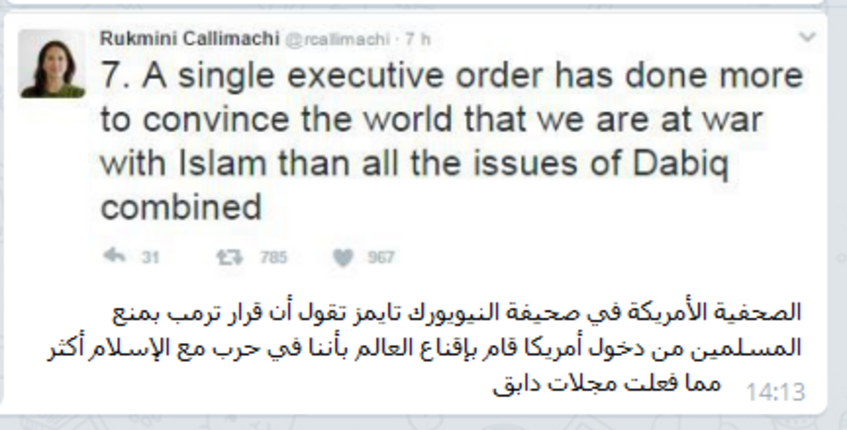
Picture 1 - A Tweet by a NYTimes journalist that was shared by ISIS followers on Telegram.
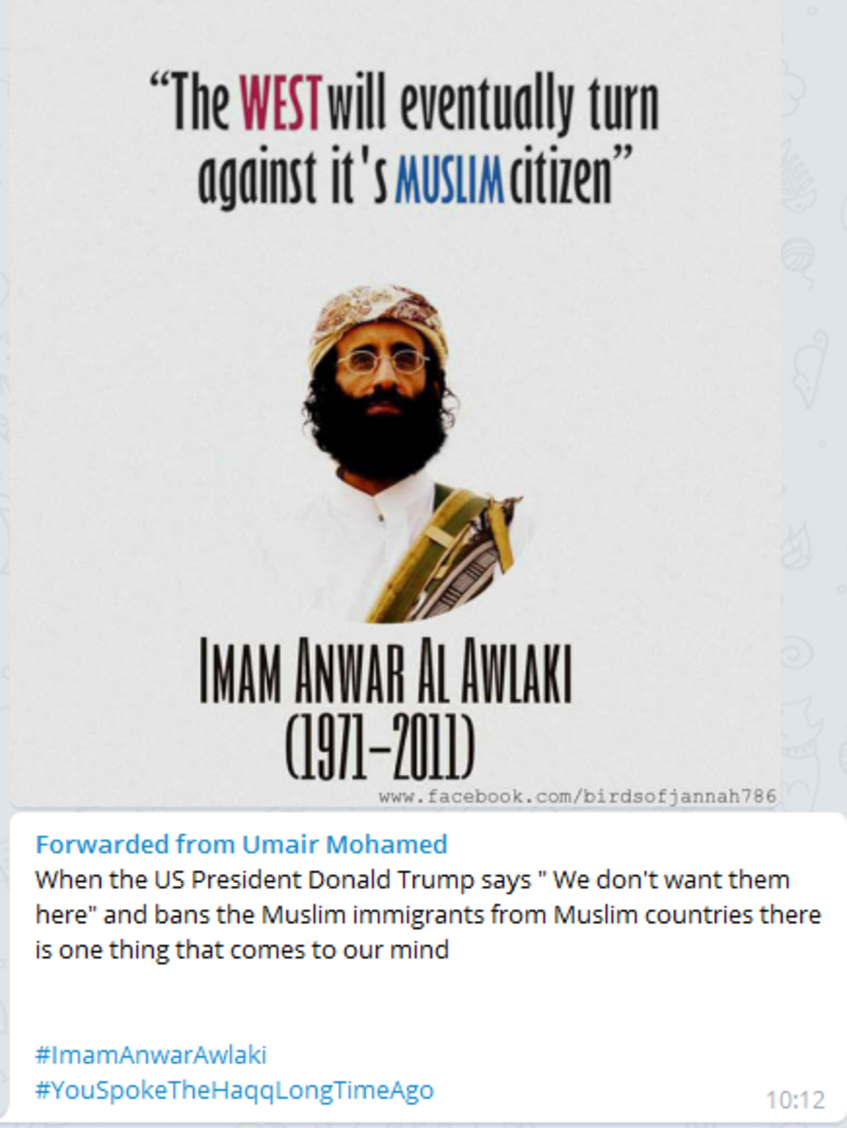
Picture 2 - One of the Telegram messages with which ISIS responded to the executive order.
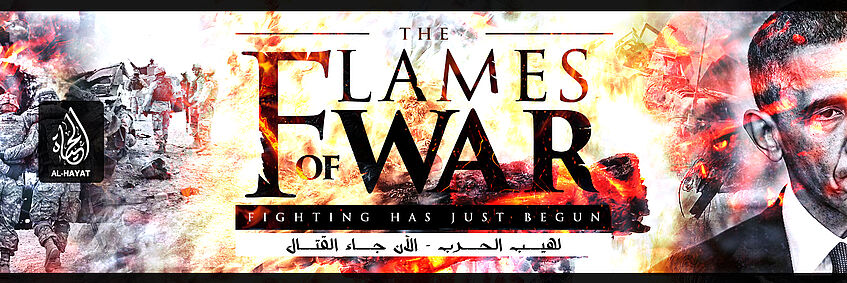
Picture 3 - The official banner used by ISIS for the video "Flames of War".
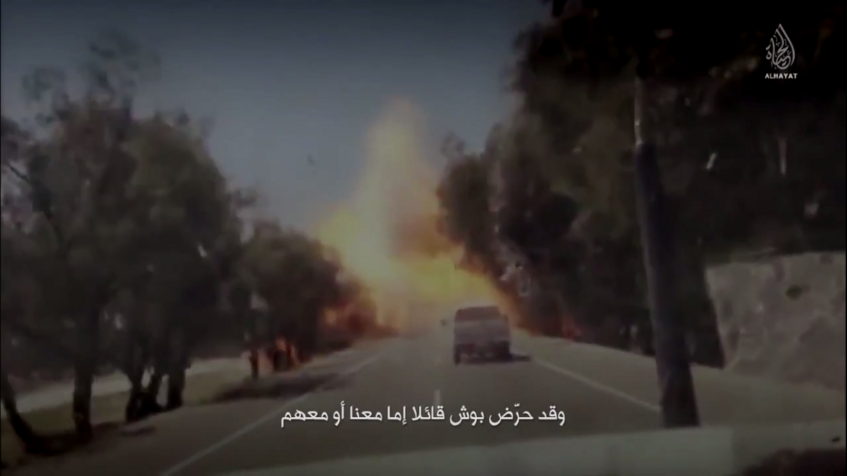
Picture 4 - A still from "Flames of War".
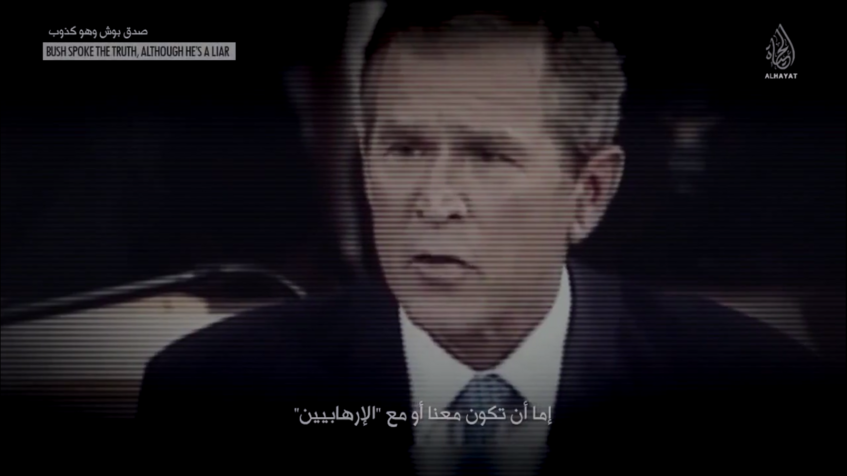
Picture 4 - A still from "Flames of War", showing US President George W. Bush.
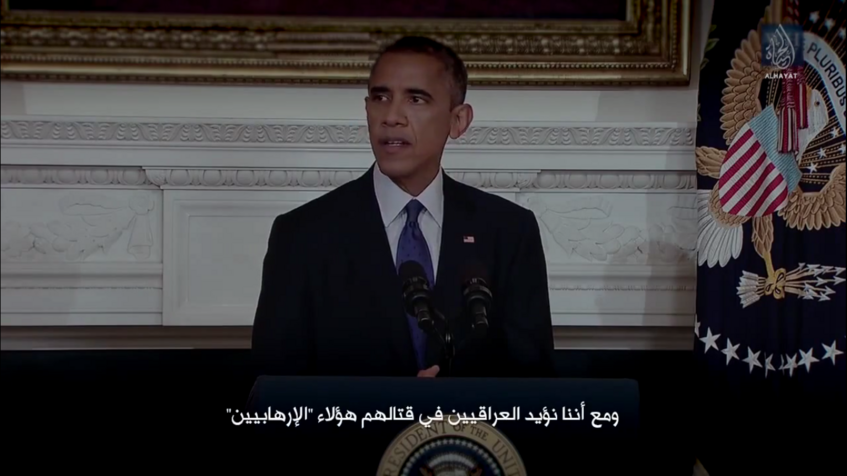
Picture 4 - A still from "Flames of War", showing US President Barack Obama.
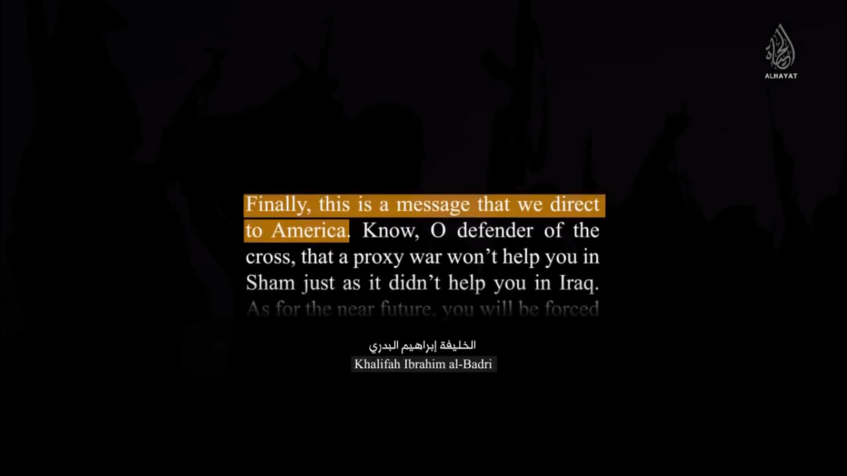
Picture 4 - A still from "Flames of War", depicting the final address to the USA in this video.
In this article, we would like to explain how ISIS reacted (and refrained from reacting) to US President Trump, especially with regard to the executive order/travel ban that he issued in January. On March 6, 2017, President Trump signed another executive order which is intended to revoke and replace the first one once it is going to take effect in mid-March. The first executive order has been and still is seen by many people inside and outside of the US as a Muslim ban in disguise. Why is that?
Largely because the first executive order blocked citizens from seven Muslim-majority countries from entering the United States for 90 days (the order had been put out of effect within a week, however). These countries were Iran, Iraq, Libya, Somalia, Sudan, Syria, and Yemen - the second executive order removed Iraq from this list. Terrorist experts pointed out that the available data does not lend itself to the conclusion that these seven countries pose any higher risk than most other countries.
So it looked like an order directed against Muslim countries and thereby another fulfillment of a campaign promise. On December 7, 2015, Donald Trump had called "for a total and complete shutdown of Muslims entering the United States until our country's representatives can figure out what is going on" (see HERE).
Now, why would a Muslim ban by the USA be of interest to ISIS? For an answer, let us look first at some of ISIS' direct responses to the travel ban on their social media channels, especially Telegram: As often, ISIS quoted some other sources concerning the ban, for example, the NYTimes journalist Rukmini Callimachi. They provided their own Arabic translation of the tweet (see picture 1). More importantly, however, was a reference to Anwar al-Awlaki (see picture 2).
Anwar al-Awlaki was a US citizen and al-Qaeda spokesperson, presumably involved in the planning of several terrorist acts. He actively promoted a violent fight against the USA. In 2011, he was killed in Yemen by a drone strike that was ordered by President Obama. On Telegram, ISIS has whole groups dedicated solely to al-Awlaki. If jihadists, when confronted with President Trump, are reminded of the 'crusader' that wages war against the Muslims - surely this cannot have a positive effect. In fact, ISIS did not even feel the need to respond excessively to the new president's actions. From the jihadi viewpoint, those actions were speaking for themselves. A mere "told you so" from ISIS to its followers is a very powerful and sufficient response given that the US President is trying hard all by himself to fit the image of the enemy.
This image has been created over many years, even decades and represents the proper context in which to situate ISIS' response to Trump and the executive orders. It is not a coincidence that the new IS spokesman, Abul-Hasan Al-Muhajir, talks about "Crusader America" on the very first page of his initial speech to ISIS' followers, published in Volume 4 of Rumiyah (a monthly IS magazine). The USA is one of the principal enemies in jihadi rhetoric in general and ISIS is not an exception. One the one hand, the US is a non-Muslim country and therefore a nation of 'unbelievers' (kuffar) whose lives should be ended (see pp. 95-114 in Rüdiger Lohlker's "Theologie der Gewalt" for more details on ISIS' enemies). But there are many of those states and ISIS declares even Muslims who do not follow their interpretations as unbelievers. What sets the USA as an enemy apart is its engagement in the Middle East. Take, for example, the high-quality video production "Flames of War". In this video, ISIS explains the reasons and motivations for the fight against America, drawing from the last decades of Middle Eastern history. They start by narrating the invasion of Iraq under US President George W. Bush and go on to talk about the developments in the Middle East (especially Iraq and Syria) under US President Barack Obama. In the end of the almost 1-hour long production, the USA is directly addressed with threats of more war and bloodshed in the near future (see pictures 3-7).
So, coming back to our initial starting point, a US White House that goes out of its way to appear islamophobic or worse feeds into the narrative that ISIS and other jihadi groups have carefully crafted over the last years and decades: That the 'Crusader' West is at war with Islam and the only defenders of 'the Muslims' are violent jihadi groups. With actions like the executive order in January, US President Trump is doing the propaganda for ISIS and their likes.
On the Burning of Prisoners
and ISIS' "cherry picking" method
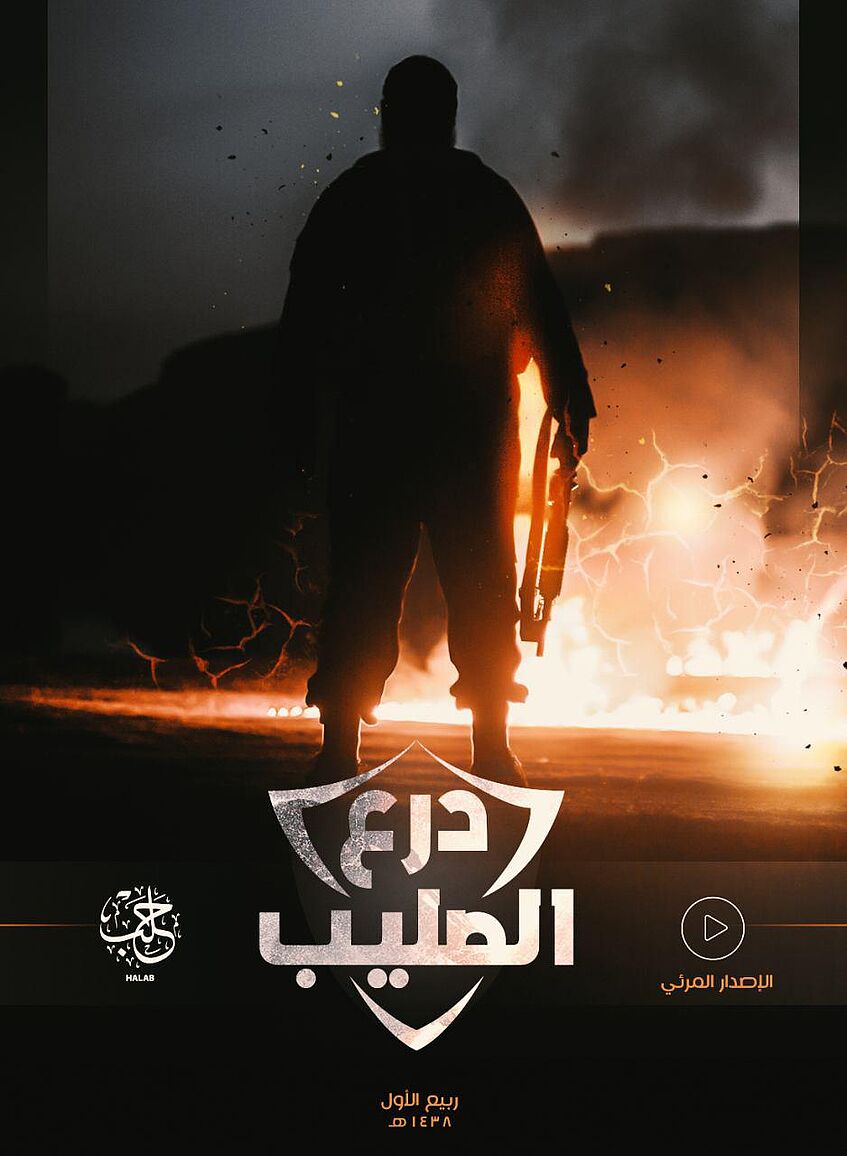
The cover picture accompanying the ISIS video.
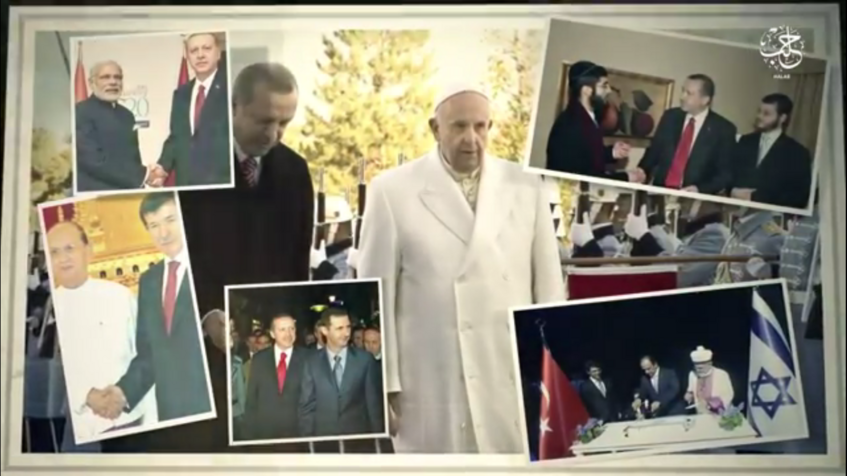
A still from the video which is supposed to show that the Turkish president Erdogan is working with other heads of state which are similarly regarded by ISIS as "enemies of Islam".
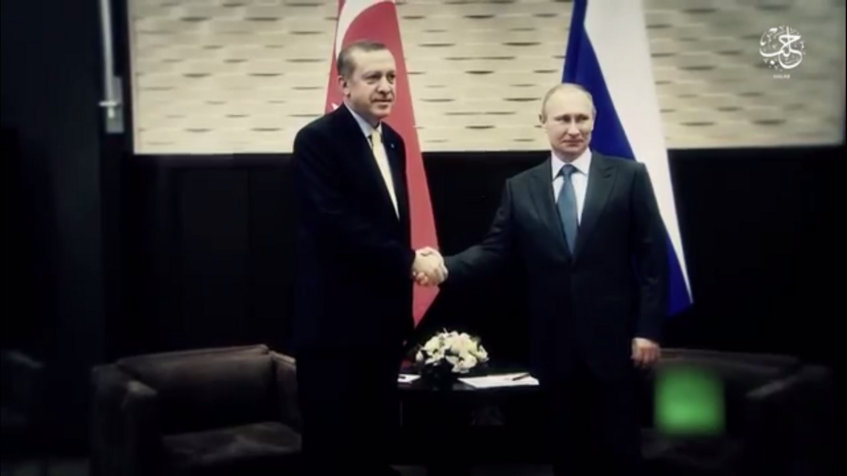
Turkish President Erdogan with Russian President Putin.
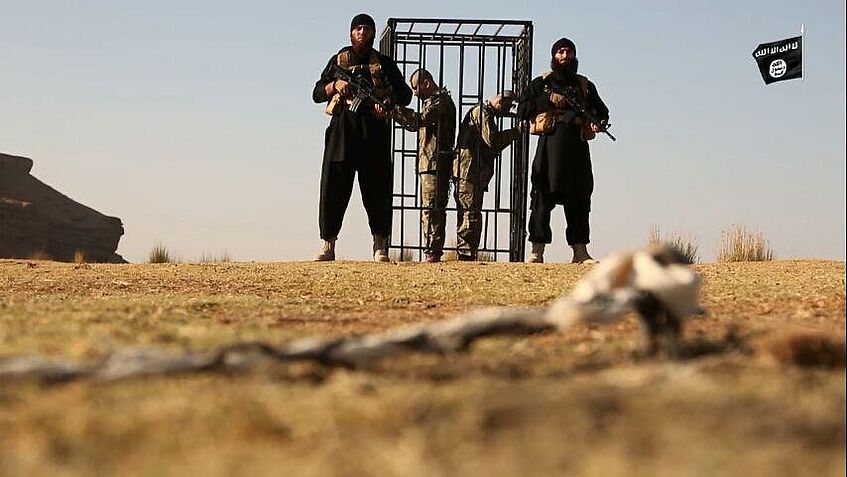
The Turkish prisoners in the cage.
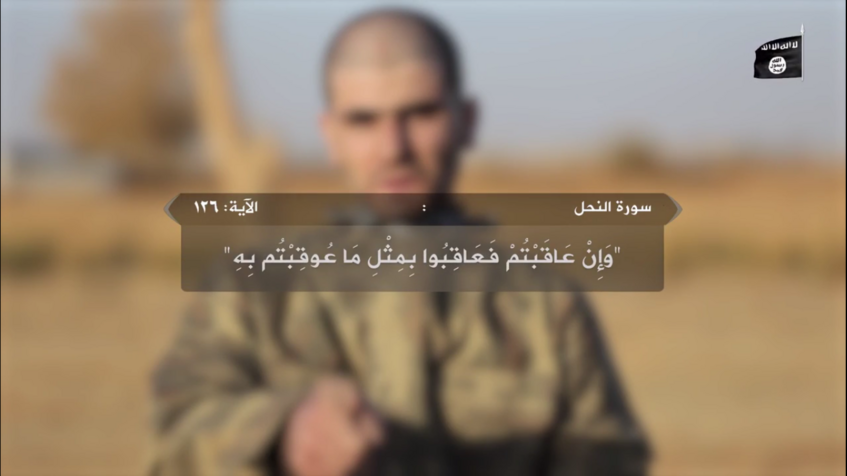
The half-verse quoted from the Surat an-Naḥl, verse 126.
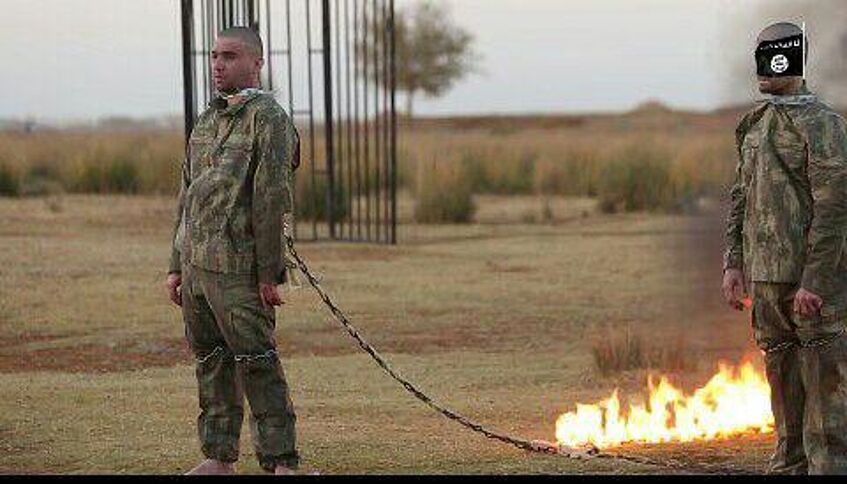
A still from the video.
On 22nd December ISIS‘ Media Office of the Halab Wilayah distributed a new video online using their various social media channels and jihadi websites. The video is entitled الصليب درع („The Cross Shield“), an apparent allusion to the Turkish army “Operation Euphrates Shield” in Syria, and shows the burning of two (allegedly) Turkish border guards. We have not been able to verify the nationalities or even identities of any of the people involved.
An interesting fact, however, is that the very first official translation that appeared almost immediately after the initial Arabic version was a Turkish one. This makes sense, obviously, since ISIS addresses Turkey, especially the army and the government, directly in the video and wants Turkish people to see and understand the video. Its message is clear:
First, the Turkish government and its president are depicted as waging war against “all Muslims” in Syria, particularly against the city of in al-Bab. Pictures and videos are displayed which show Erdogan alongside various heads of state, amongst them US president Barack Obama and Vladimir Putin, the president of Russia. This is interspersed with a lot of material allegedly from al-Bab, demonstrating the aftermath of the airstrikes there. Naturally, we do not see dead ISIS fighters (which Turkey is officially targeting in al-Bab) but only dead and wounded civilians, especially children (we will come back to this later on).
After some more minutes of footage from ISIS men fighting on various battlefields in Syria, we are finally introduced to an ISIS fighter who claims to be a Turkish foreign fighter and who presents two prisoners in a cage, who are said to be Turkish border guards captured several weeks ago. They then have to “confess” to the killings that Turkey was accused of in the scenes before. Different from the burning of the Jordanian pilot Mu’ādh al-Kasāsbeh in 2015, they are led out of the cage but have chains around their necks to hold them from fleeing. These chains are connected to ropes of cloth. Shortly before those are set on fire by the ISIS man we have already seen, a citation from the Quran is shown (see picture below). It is from Surat an-Naḥl, the 16th Surah of the Quran, called “The Bee” – Verse 126.
Here is the English translation from the Study Quran (p. 691-692):
“And if you would punish, then punish with the like of that wherewith you were punished.”
The following horrific sequence goes on for several minutes and spares the viewer no detail of the soldier’s agonies who are burned alive. After the two Turkish soldiers have died, the ISIS man who ignited the fire and was apparently watching the whole time comes back on the screen and says: “You burned the Muslims, O government of Turkey. So this will be your fate, by Allah’s God’s permission.” He then pours some inflammatory liquid on the bodies in order to make them burn longer.
One can watch ISIS’ affiliates and members discussing the video after its release in their chat rooms and via messaging services. They try heavily to approve and sanction the video’s message by posting more videos and pictures of the civilians and, again, especially children who get wounded, burned and killed in al-Bab. Pictures of the dead bodies of babies are put directly next to pictures of the burned Turkish pilots’ bodies in order to emphasize that this is “the same”.
Now, let us come back to the Quran passage used in the video to justify the burning of the pilots. ISIS cites correctly from the Quran but, however, only the first part of that verse. The full verse reads (in the English translation, again from the Study Quran, p. 691-692):
“And if you would punish, then punish with the like of that wherewith you were punished. But if you are patient, then that is better for the [person who is] patient.”
And the rest of the Surah reads:
“So be patient, and thy patience is only with God. And grieve not on their account, nor be distressed by what they plot. Truly God is with those who are reverent, and those who are virtuous.”
So what did ISIS do here? They cited only the part of the verse, not even an entire verse but merely half of it, only the part which suited them. This clearly shows that the makers of the video did not expect the ISIS followers to know how the Surah goes on. The Quran clearly states that it is better to be patient and thereby not to punish the same way one was punished. And this is only the text itself, not even taking into account the Tafsīrs, the commentarial/exegetical literature which interprets the Quran. The Study Quran mentions three of them in the footnote to this Verse: All of them (Fakhr ad-Dīn ar-Rāzī, Muḥammad ibn Jarīr aṭ-Ṭabarī and Abu’l-Qāsim Maḥmūd ibn ‘Umar az-Zamakhsharī) agree that the sentence is clear in its meaning: Muslims are not allowed to punish harsher than they were themselves harmed and it is even better for them to renounce retaliation altogether. Aṭ-Ṭabarī mentions the story of how Makkah was eventually surrendered to the Prophet Muḥammad, whose followers urged him to have his vengeance and yet he let mercy prevail and took over the city peacefully.
ISIS quoted the same half-verse already when they burned the Jordanian pilot mentioned above and there was an outrage by numerous Muslim scholars back then. One of them was Shaykh Muhammad Al-Yaqoubi, who discusses the burning of the Jordanian pilot in his book (mentioned in our Articles & Books section). Since the same act was carried out by ISIS in the video described above, it is clear that one can apply Shaykh Al-Yaqoubi’s reasoning in the more recent case as well.
There are several lines of argument employed by Shaykh Al-Yaqoubi in his refutation of ISIS’ attempt to justify the burning of the Jordanian pilot:
- Quoting the Quran (47:4), he states that prisoners of war in general have to be released although Shaykh Al-Yaqoubi does confirm what ISIS is also saying, that the Prophet Muhammad did both – he released prisoners but also killed some. However, Shaykh Al-Yaoubi sees the Muslims bound by “The Convention relative to the Treatment of Prisoners of War” from 1949 which was signed by 196 countries, amongst them several Muslim ones. He also mentions several scholars who agreed that the killing of prisoners is forbidden (ḥarām).
- More specifically regarding the punishment with fire, the Shaykh mentions sound narrations about the Prophet Muhammad who is reported to have said: “No one has the right to punish with fire, except the Lord of the fire [=Allah]!” (See p. 47, footnotes 12-14 for the different references). One of the works which transmitted this is the Ṣaḥīḥ al-Bukhārī. A text allegedly well-known to ISIS, since they cite from it in numerous videos and texts, well aware that this is one of the most famous ḥadīth collections, generally regarded very reliable. They quote from it, for example, in their checkpoint video already described by us below. Now, why don’t they cite from it now? This is just another example of their "cherry picking" method, to cite only what justifies their actions, disregarding the context or any other issue that relates to the topic. Al-Yaqoubi also states the principle that muslims are bound by the Shariah even on the battlefield and therefore cannot transgress the laws mentioned by him, whether in times of peace or war.
- Lastly, Shaykh Al-Yaqoubi refers the reader to several traditions and laws regarding the prohibition of torture. However, we will come back to this issue in a separate article on our website.
It should be clear by now, that the burning of not just a human, but any living being is regarded forbidded in Islam by a majority of scholars, based on textual evidence from the Quran, narratives about the prophet and numerous works about law (fiqh). ISIS, however, ignores all of this in the video described above and not just that, they ignored the huge backlash from the Muslim scholarly world after they burned the Jordanian pilot. As if nothing happened, they just go ahead with burning two Turkish border guards and do not even refer to any of the arguments brought against them since they killed the pilot in the same way. All they do is they quote the exact same half-verse from the Quran, just as they did in order to justify the pilot’s burning. ISIS’ followers may try to ignore their own fallacies – the Muslim world does not.
Checkpoints & Satire on them
In this post, we are analyzing an ISIS video and a directly corresponding satire produced for Bass Māt Waṭan, a popular show on the libanese TV broadcaster LBC. The text explaining the satirical video is an adapted translation from the analysis of this video by Karoline Köster, as published in her MA thesis on pp 54-56 (you can download her thesis in German HERE). The transliteration of the Arabic quotations from the video is also hers.
Guilt by association: ISIS reasoning for executions at checkpoints
The sequence is taken from the ISIS video Salil al-sawarim, part 4 (SAS4). This is one of the first major ISIS video releases in 2014 when the group managed to conquer swathes of territory in Iraq and subsequently Syria, leading to the self-proclaimed caliphate today. SAS4 documents by the camera lenses of the jihadis how territory was integrated into their realm of power, by, for example, singling out targets as seen in the sequence, or by systematically ‘integrating’ Sunnites into their ranks in the Sunni regions of Iraq. The Sunnites were offered to repent and thus renounce their former belonging to the Iraqi nation state and thus become ‘citizens’ as Sunni Muslims of the self-designated “Islamic State”. Further information on SAS4 and the network that carried and ensured its dissemination on – at the time – Twitter, is available on the jihadica blog (HERE and HERE).
In the sequence shown here, the viewers are taken to the plains of Anbar province, where ISIS is building a checkpoint on a remote desert highway. Jihadist videos often show soldiers on patrols, search and destroy missions or maintaining checkpoints to single out individuals such as government workers, plain-clothes army members, foreigners, etc.
As these groups often operate within their home territory, they know who to look for. The video intends to convey that ISIS has mastered this tactic, as the checkpoint seems professionally established, with several cars, including several Toyota pick-ups mounted with .50 caliber heavy machine guns. The “intelligence” branch of IS is part of the checkpoint. A Mujahid fully dressed in black has a laptop with an apparent database on it where he compares the names of the identity cards given to ISIS-soldiers at the checkpoint.
The theme of this part of the film is defined as “singling out the apostates for extermination based on inquiry and cross checking with a digital database of men wanted by the Mujahidin.”
Some of those stopped are rightfully confused; the IS checkpoint resembles an Iraqi army checkpoint and ISIS fighters are wearing army-issued uniforms; no ISIS-symbols, icons and no black flag are seen at the checkpoint. Rather, ISIS fighters wear the insignia of the Iraqi army, badges with the Iraqi flag on their arm, and in some cases the “Anti-Terror-Unit, Special Forces” badge. The film describes these sequences as fighters “singling out one of the local [Iraqi] government criminals in [the province of] Salah al-Din.”
The use of checkpoints such as these and the targeted execution of government employees, Iraqi army soldiers/policemen, and non-Sunnis, especially Shiites (often identified by their names), has enabled ISIS to drastically root out key figures of the Iraqi government. The film is documenting a phase of territorial consolidation prior to ISIS’ conquest of large Iraqi cities, especially Mosul in June 2014.
Two men are taken out of their SUV. One is identified as a student, as he had claimed, and released, while the other is a high ranking Iraqi government official and taken aside. He is seen in the following scene sitting on the ground in front of an open grave and shot in the back of his head. Like previously, the film justifies these actions by citing a historical scholar, in this case Imam al-Bukhari, the most important collector of the sayings and doings (hadith) of the prophet Muhammad as described by his companions:
“Imam al-Bukhari – may God have mercy with him – said about the rafida:
'I do not differentiate between praying behind a Jew, a Christian, or a rafidi. Do not eat the meat they slaughter. Do not observe their funeral processions and do not tend to their sick.'”
The quote by Imam al-Bukhari, a renowned hadith collector, is the essence of many anti-Shiite writings and sentiments, as discussed on the al-Burhan website (“The Ruling of the Scholars of Islam and their Fatwas in regard of Shiism”).
The victim is guilty by association. First and foremost, he is executed for being a Shiite. Second, as he is Shiite and a member of the Iraqi government, the reasoning for IS to execute him is clear: (i) as a Shiite member of the Iraqi government, he is directly responsible for the marginalization of Iraqi Sunnites, (ii) he bears the guilt of having collaborated with American forces during the occupation of the country, (iii) he must pay a personal price for the massacre of Sunnis in April 2013 in Hawija, Anbar province. Immediately after the citation of Imam al-Bukhari, both a civilian Iraqi government employee and a plain-clothes Iraqi soldier captured at the checkpoint are executed.
The men, one of them identified by his ID card as Mash’al Khalif Shaghir, are forced to sit on the desert ground before a dug out grave with their hands tied behind their back. They fall into their graves when shot in the back of the head. Next to the executioner stands a Mujahid holding the ISIS-flag.

Checkpoints and background checking.

Identifying a high ranking Iraqi governmental official and justifying his subsequent execution. The IS-fighter on the left wears official Iraqi army Special Forces badges.

The execution of Mash’al Khalif Shaghir – an Iraqi soldier and hence an “enemy of Islam”.

The couple in their car, shortly before approaching the checkpoint. © Bass Māt Watan

The woman already threatened at gunpoint. © Bass Māt Watan
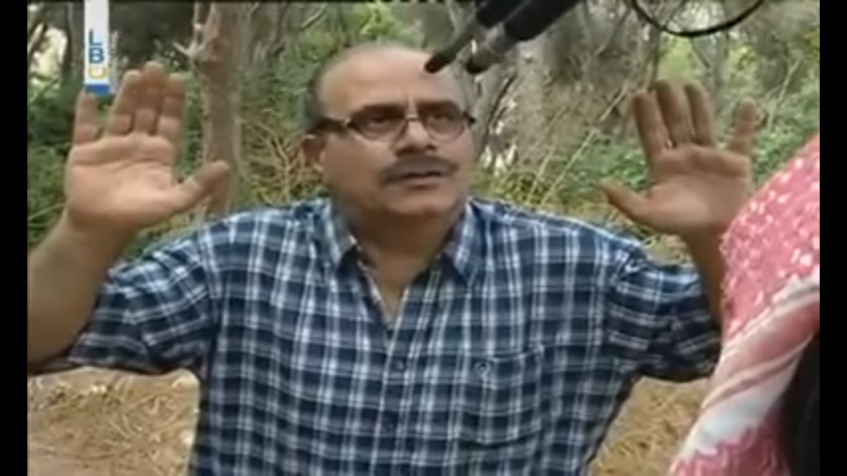
The man reciting from the Bible in Arabic. © Bass Māt Watan
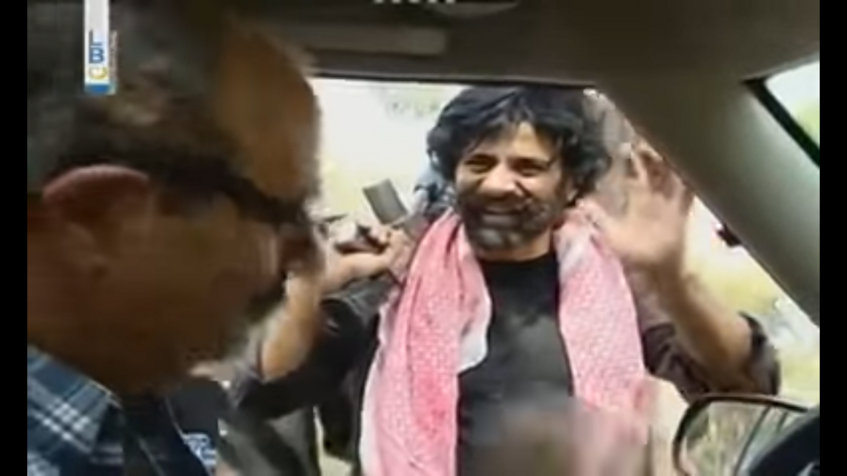
A friendly goodbye after deceiving the "mujahideen". © Bass Māt Watan
Checkpoint satire
In THIS video, produced for the program Bass Māt Watan, we see a married Christian couple approaching an IS-held checkpoint. Those men immediately put up threatening behavior and keep the couple in check with their guns drawn since they recognize them to be non-Muslims. They threaten:
izā kuntum naṣārā aw arāfiḍ aw murtaddīn sawfa naḏbāḥuho wa-nasbīki.
When you’re Christians or apostates, we will kill him [= the man] and take her [= the woman] prisoner.
Here the satirists aptly demonstrate the usage of fundamentalist terminology (ʾarafiḍ, murtaddīn) paired with the effort to speak fuṣḥā, the ‘higher’ Standard/Written Arabic, especially apparent in the use of the future form. The particle sawfa is practically not existent in the levantine dialects and marks therefore a conscious withdrawal from vernacular Arabic. This usage of Arabic is a very common feature throughout actual extremist propaganda.
In the following sequence, the threatened man is kneeling on the ground and tries to assure the IS fighters that he is not one of their enemies but a Muslim too. {That implies, of course, a Muslim as they want Muslims to be.} One of the fighters wants him to prove this by reciting a passage from the Qur’ān and so we hear:
hā anā ursilukum ka-ġanamin wasṭa ḏiʾābin fa-kūnū ḥukamāʾa ka-l-ḥayyāt wa-busaṭāʾa ka-l-ḥamām.
“See, I am sending you out like sheep into the midst of wolves; so be wise as serpents and innocent as doves.“ (Mat 10,16; translation from The New Oxford Annotated Bible with Apocrypha: New Revised Standard Version. OUP, 2010)
This verse stems from the Bible, as the woman mentions to her husband after the IS men allow them to pass the checkpoint. The husband’s answer is the sketch’s punchline:
bʾəllek hāḏa lā byaʿrəf al-qurʾān yaʿni biḏbaḥ nās wa-bitqattaʿa r-rūs, walla ᵊskitī.
„I am telling you, this guy does not know the Qur’ān, he slaughters humans and cuts off their heads, so be quiet.”
This pointe can be seen as a direct reference to the scene in the checkpoint video above, where ISIS quotes a hadith by al-Bukhari, thereby demonstrating their knowledge of Islamic texts. The assumption that an IS fighter is unable to tell the Qur’ān from the Bible is, of course, a stark contrast to ISIS’ self-image as being rooted in the Qur’ān and the Sunna, the records of the Prophet Muḥammad’s and his companions’ teachings and sayings.
ISIS draws its legitimacy in large part from a literal and, in their view, correct understanding of those sources. Questioning their knowledge and understanding of this material shakes up their entire ideology. Furthermore, the man's answer seems to imply that it was obvious to him that the jihadist does not know the Qur’ān because he "slaughters humans and cuts off their heads" - so anyone who does these things, cannot know or at least cannot have understood the Qur’ān.
The Nahdlatul Ulama
The Nahdlatul Ulama (NU) is the world's largest Sunni-muslim organization, with its headquarters in Indonesia. In May 2016, the NU hosted an “International Summit of Moderate Islamic Leaders” (ISOMIL) in the Indonesian capiral Jakarta. As a result of this summit, the NU published "The Nahdlatul Ulama Declaration".
This declaration is unique in its content and form. The NU explicitly acknowledges that terrorist groups like the self-declared "Islamic State" (mis-)use legitimate Islamic texts and sources in order to justify their deeds. Additionally, the NU fears that the identification of "Islam" with "Islamic-legitimized terrorism" is going to amplify and perpetuate the Islamophobia that has spread in Europe and North-America. This would further strengthen the appeal of far-right and populist parties there.
The NU stands for a coherent interpretation of Islamic sources and represents religious pluralism and tolerance. The NU "counter-narratives" against the propaganda by ISIS are based - just like the extremists' content - on a coherent theology with the important difference that the NU strongly rejects any violence against Mulims and non-Muslims. This is one of the basic pillars of Indonesian democrary and civil society.
This allows the NU to form a comprehensive sunni Islamic identity with the general consensus of Indonesian society - pluralism, tolerance and peace - as an integral part of it. This contradicts the theology of ISIS, al-Qa’ida and similar groups.
Below follows a video that shows Gus Yahya Cholil Staquf, the Secretary-General of the NU's supreme council and other religious leaders of the NU and how they talk about "Apostasy and Destruction". They critically scrutinize events like the destruction of historical sites in Iraq, Syria and the Arabian peninsula. The statements in this video clearly show that the NU recognizes that ISIS creates and adapts a "Theology of Violence" based on the religious sources they and other extremists use. Prof. Rüdiger Lohlker of the University of Vienna's Department of Oriental Studies demonstrates this as well in his book "Theologie der Gewalt" (see our Books section).

